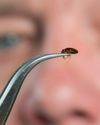
Remotely operated underwater vehicles help us explore the oceans at depths that would be impossible for divers.
The oceans are the biggest, wildest, least understood part of the planet. But we’re getting to know them better every day, thanks to a host of technologies that are fathoming the depths in new and inventive ways. Some researchers are capturing things from the sea and transporting them into the lab to study in detail; others are rigging the oceans with novel sensors and devices, or probing them with algorithms. Together, these approaches are offering brand new views of the underwater world, at a time when it’s never been more important to decipher the inner workings of the oceans.
From coral reefs to deep-dwelling jellies, the oceans’ living inhabitants face greater threats from human activities than ever before. The seas are polluted and overfished, marine habitats are being destroyed, and new impacts – such as deep-sea mining – are fast approaching. It’s also becoming increasingly clear just how critical the oceans are for the rest of life on Earth. These enormous, ever-shifting waters play a vital role in weather and climate systems, provide food and livelihoods for human populations around the world, and are home to great swathes of unknown biodiversity. In order to understand and protect life on this planet, we have to look to the oceans.
VIRTUAL E-REEF BUILDERS
Diese Geschichte stammt aus der November/December 2020-Ausgabe von Very Interesting.
Starten Sie Ihre 7-tägige kostenlose Testversion von Magzter GOLD, um auf Tausende kuratierte Premium-Storys sowie über 8.000 Zeitschriften und Zeitungen zuzugreifen.
Bereits Abonnent ? Anmelden
Diese Geschichte stammt aus der November/December 2020-Ausgabe von Very Interesting.
Starten Sie Ihre 7-tägige kostenlose Testversion von Magzter GOLD, um auf Tausende kuratierte Premium-Storys sowie über 8.000 Zeitschriften und Zeitungen zuzugreifen.
Bereits Abonnent? Anmelden

TAKE IT SLOW
Slow running is a fitness trend with some hard and fast science behind it

Physics, AI and music share a common thread. You just have to know where to look
Studying science can lead you in many directions and open doors to unexpected possibilities along the way

BED BUGS VS THE WORLD
When bloodthirsty bed bugs made headlines for infesting Paris Fashion Week in 2023, it shone a spotlight on a problem that's been making experts itch for decades: the arms race going on between bed bugs and humans

Kids are the key to understanding obesity. But we need more of their genes...
We can unravel the role that bodyweight plays in disease, but we need a bigger, more diverse, sample of genetic material to do so

COVID inquiry: What did we learn and what can we do better in future pandemics?
Masks, social distancing, lockdowns... how effective was the UK's response to the COVID-19 pandemic?

One hormone could be the key that unlocks a cure for morning sickness
The nausea and vomiting that, in extreme cases, can endanger mothers and babies might soon be just a memory

THE WORLD'S WEIRDEST CREATURES
Under the sea and upon the land, some animals look - to us - pretty strange...

WHEN MIND AND MACHINE COLLIDE
First, Elon Musk wanted to make electric cars ubiquitous, then he wanted to make space exploration a private enterprise. Now, with Neuralink, his newest venture, Musk hopes to merge humans and artificial intelligence. Turns out, it might not be such a crazy idea...

COME OUT OF YOUR SHELL
Social anxiety is more than just being shy. It's a phobia born out of our evolutionary past. But that raises a puzzling question: why do so many of us fear human interaction when we're supposed to be the most sociable species on the planet?

SPACE ODDITIES
Take a tour of the weirdest spots in the universe, where the 'normal' rules don't apply. Places that squeeze time, blow bubbles and even rain glass... sideways